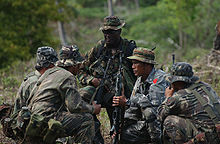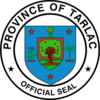Tarlac: Difference between revisions
FromTarlac (talk | contribs) No edit summary |
|||
| Line 84: | Line 84: | ||
==Geography== |
==Geography== |
||
Eastern Tarlac is a plain, while Western Tarlac is hilly to mountainous. Because of this, the province owns a large portion of mountains like Mt. Telakawa, which is the highest mountain in the province located at Capas, Tarlac. Mt. Bueno is located also in Capas. The other mountains are Mt. Dueg and Mt. Maasin, found in the municipality of San Clemente. Also noted are Mt. Papaac, Bacsay, Cayasan and Birbira of Camiling. The whole of Mayantoc and San Jose are mountainous so it is suitable for the highest natural resources and forest products in the province such as coal, iron, copper, vegetables, fruits, log fires, sand, rocks and forest animals such as wild boar, deer etc. |
Eastern Tarlac is a plain, while Western Tarlac is hilly to mountainous. Because of this, the province owns a large portion of mountains like Mt. Telakawa (Straw hat Mountain), which is the highest mountain in the province located at Capas, Tarlac. Mt. Bueno, Mt. Mor-Asia and Mt. Canouman is located also in Capas. The other mountains are Mt. Dueg and Mt. Maasin, found in the municipality of San Clemente. Also noted are Mt. Papaac, Bacsay, Cayasan and Birbira of Camiling. The whole of Mayantoc and San Jose are mountainous so it is suitable for the highest natural resources and forest products in the province such as coal, iron, copper, vegetables, fruits, log fires, sand, rocks and forest animals such as wild boar, deer etc. |
||
===Political=== |
===Political=== |
||
Revision as of 00:54, 23 December 2010
Tarlac | |
|---|---|
 Map of the Philippines with Tarlac highlighted | |
| Country | |
| Region | Central Luzon (Region III) |
| Founded | 1872 |
| Capital | Tarlac City |
| Government | |
| • Type | Province of the Philippines |
| • Governor | Victor Yap (NPC) |
| • Vice Governor | Pearl Angeli Pacada (Lakas-Kampi-CMD) |
| Area | |
| • Total | 2,736.6 km2 (1,056.6 sq mi) |
| • Rank | 49th out of 80 |
| Population (2007) | |
| • Total | 1,243,449 |
| • Rank | 17th out of 80 |
| • Density | 450/km2 (1,200/sq mi) |
| • Rank | 12th out of 80 |
| Divisions | |
| • Independent cities | 0 |
| • Component cities | 1 |
| • Municipalities | 17 |
| • Barangays | 511 |
| • Districts | 1st to 3rd districts of Tarlac |
| Time zone | UTC+8 (PHT) |
| Spoken languages | Kapampangan, Tagalog, Ilocano, Pangasinan, English |
Tarlac is a landlocked province of the Philippines located in the Luzon Island. Its capital is Tarlac City. Tarlac borders Pampanga to the south, Nueva Ecija to the east, Pangasinan to the north, and Zambales to the west. It is a part of Central Luzon, which is composed of Aurora, Bataan, Bulacan, Nueva Ecija, Pampanga, Tarlac, and Zambales.
Demographics
As of the 2000 census, Tarlac has a population of 1,068,783. Its population density is 350/km².
In the southern half of the province Capampangan is the spoken language whereas Ilocano and Pangasinan dominate the northern half. Tagalog, being the country's national language, is widely understood throughout the province.
Economy
The economy of Tarlac is dominantly agricultural. Principal crops are rice and sugarcane. Other major crops are corn and coconut; vegetables such as eggplant, garlic, and onion; and fruit trees like mango, banana, and calamansi.
Because the province is landlocked, its fish production is limited to fishponds. On the boundary with Zambales in the west, forest lands provide timber for the logging industry. Mineral reserves such as manganese and iron can also be found along the western section.
Tarlac has its own rice and corn mills as well as sawmills and logging outfits. It has three sugar centrals. Other firms service agricultural needs such as fertilizer. Among its cottage industries, ceramics making has become important because of the abundant supply of clay. Some of the major industries here are the making of the delicious and famous Chicharon and Iniruban in the municipality of Camiling, Ylang Ylang products of Anao and the Muscovado sugar products of Victoria. Besides those products, the province also boosts its sugar products in the Philippines. It is next to Negros Occidental which is the nation's sugar capital. Tilapia is also improving in Tarlac and it will soon be the Tilapia capital of the Philippines.
Geography
Eastern Tarlac is a plain, while Western Tarlac is hilly to mountainous. Because of this, the province owns a large portion of mountains like Mt. Telakawa (Straw hat Mountain), which is the highest mountain in the province located at Capas, Tarlac. Mt. Bueno, Mt. Mor-Asia and Mt. Canouman is located also in Capas. The other mountains are Mt. Dueg and Mt. Maasin, found in the municipality of San Clemente. Also noted are Mt. Papaac, Bacsay, Cayasan and Birbira of Camiling. The whole of Mayantoc and San Jose are mountainous so it is suitable for the highest natural resources and forest products in the province such as coal, iron, copper, vegetables, fruits, log fires, sand, rocks and forest animals such as wild boar, deer etc.
Political
Tarlac is subdivided into 17 municipalities and 1 city. These divisions are further subdivided into 511 barangays. The province comprises three congressional districts.
City
Municipalities
Physical
The province is situated at the center of the central plains of Luzon, landlocked by four provinces: Pampanga on the south, Nueva Ecija on the east, Pangasinan on the north, and Zambales on the west. Approximately 75% of the province is plain while the rest is hilly to mountainous.
Like the rest of Central Luzon, the province has two distinct seasons: dry from November to April and wet for the rest of the year.
History
Tarlac's name is a Hispanized derivation from a talahib weed called in Ilokano word "Malatarlak". Tarlac was originally a part of the provinces of Pampanga and Pangasinan. It was the last Central Luzon province to be organized under the Spanish administration in 1874.
During the Philippine Revolution of 1896, Tarlac was one of the first eight provinces to rise in arms against Spain. It became the new seat of the first Philippine Republic in March 1899 when Emilio Aguinaldo abandoned the former capital, Malolos, Bulacan. This lasted only for a month, as the seat was moved to Nueva Ecija in Aguinaldo's attempt to elude the pursuing Americans.
On October 23, 1899, Gregorio Aglipay, military vicar general of the revolutionary forces, called the Filipino clergy to a conference in Paniqui. There, they drafted the constitution of the Philippine Independent Church. They called for the Filipinization of the clergy, which eventually led to a schism in the Roman Catholic Church in the Philippines.
Tarlac was captured by American forces in November 1899. A civil government was established in the province in 1901.
During the World War II, Camp O'Donnell in Capas became the terminal point of the infamous "Bataan Death March", involving Filipino and American soldiers who surrendered in Bataan on April 9, 1942. The camp was so overcrowded that many allied prisoners who survived the grueling march died here of hunger and disease.
In the beginning of 1945, combined American & Filipino military forces with the recognized guerillas liberated Camp O'Donnell. The Raid at Capas resulted in the rescue of American, Filipino and other allied Prisoners of War.
| Invasion of Tarlac | |||||||
|---|---|---|---|---|---|---|---|
| Part of World War II | |||||||
| |||||||
| Belligerents | |||||||
|
|
| ||||||
On January 20, 1945, Tarlac was recaptured by combined Filipino and American troops together with the guerrilla fighters against the Japanese Imperial forces during the liberation.
In the early 1950s, Tarlac was the hotbed of the Hukbalahap, a local communist movement. It was suppressed at first but had resurgence in 1965.
Famous personalities
Tarlac is the home province of the Cojuangco and Aquino families, most notable for producing democracy icons Ninoy and Cory Aquino, as well as their son, incumbent President Noynoy Aquino.
Pulitzer Prize winner General Carlos P. Romulo hails from the town of Camiling. He served as president of the University of the Philippines, Philippine ambassador to the United Nations, president of the General Assembly and chairman of the Security Council.
Former education secretary Onofre D. Corpuz was also from the town of Camiling. Sec. Corpuz also served as president of the University of the Philippines.
Tarlac is also the home province of actress-turned-politician, Vilma Santos, who is the incumbent governor of Batangas province.
Tarlac is also home province of General Paulino Santos (from Camiling), who served as commander of Penal Colonies of South-Western Mindanao. The town of Rajah Buayan was later renamed to General Santos City on his honor.
Tarlac Military Testing Ground

Recently the Philippine Army has used Crow Valley in Capas, Tarlac as a testing ground for both Philippine forces and allies. Many of the Philippine Military testings were done on March 17, 2006 [1] most likely as a part of Operation Enduring Freedom - Philippines.
Belenismo sa Tarlac
“Belenismo sa Tarlac” (project to transform it to “Belen capital” of the Philippines) was launched by Isabel Cojuangco-Suntay, sister of former Ambassador Eduardo Cojuangco Jr., president of the Tarlac Heritage Foundation. 2007 Belen Festival began in September, with the first Belen-making workshop to Dec. 16. Sen. Loren Legarda led the awarding of 16 winners in 5 categories—personal, grand, monumental, municipal and diorama. The Tarlac police office Belen, built by at least 24 policemen, won the first prize; Asiaten Hotel was second and restaurant Coconut Grill was third.[1]
See also
External links
- Executive Order No. 561: FORMATION OF THE "SUPER" REGIONS AND MANDATE OF THE SUPERREGIONAL DEVELOPMENT CHAMPIONS
- North Luzon Super Region: Potentials
- North Luzon Super Region: Projects



